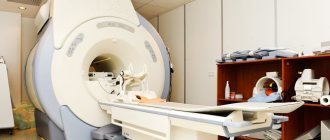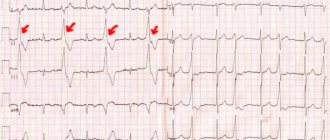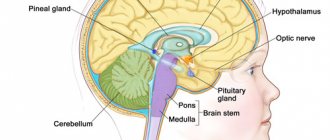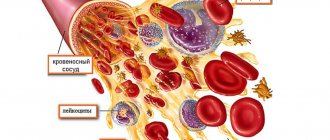A good blood supply to the brain is the main component of its full functioning. If violations occur in this process, first minor and then sometimes irreversible disruptions in the work of this body inevitably occur. One of the manifestations of such disorders is the medical diagnosis – vascular genesis.
Ischemic stroke
Ischemic stroke is also called cerebral infarction. It differs from other types of strokes in that it causes circulatory problems and the death of brain cells. The main cause of this disease is blockage of arteries leading to the brain by blood clots. If a person is suspected of having an ischemic stroke, they should be hospitalized immediately.
Prognosis for amenorrhea
The prognosis for amenorrhea depends on the causes and duration of the cycle disorder. In women with primary amenorrhea with a large degree of underdevelopment of the genital organs, treatment may not give positive results. Psychogenic forms of amenorrhea that exist for a short time are easily treatable. When treated with sex hormones, the functions of the nervous system, pituitary gland and ovaries are normalized. In cases of prolonged secondary amenorrhea, long-term hormonal treatment is required.
What other genesis does encephalopathy have?
When the causes of encephalopathy cannot be determined, or when it has several causes, it is said to be encephalopathy of complex origin. Typically, this type of encephalopathy appears immediately in the second stage of the disease. There are three stages of encephalopathy. Typically, patients do not pay attention to the symptoms of the first stage, seeing a doctor only in the second or later, which greatly complicates treatment and rehabilitation. Most often, mixed encephalopathy occurs on the basis of the dyscirculatory form of the disease.
Symptoms of amenorrhea
The clinical picture of all forms of amenorrhea has many common symptoms.
Symptoms of primary amenorrhea
Patients suffering from primary amenorrhea usually experience:
- little uterus,
- conical cervix,
- vagina is narrow,
- the vaginal vaults are flattened,
- scanty development of hair on the pubis, in the armpits,
- development of mammary glands is slowed down.
Symptoms of secondary amenorrhea
With short-term secondary amenorrhea, changes in the reproductive apparatus may be absent. With a long course of the disease, changes occur in the reproductive system associated with trophic disturbances. These include:
- decreased secretion of glands,
- atrophy of the mucous membranes and muscular elements of the genital organs,
- changes in the tone of the uterus and ligamentous apparatus,
- reduction in the size of the ovaries, etc.
With secondary amenorrhea, the following may appear:
- headache,
- irritability,
- fast fatiguability,
- sensation of sudden heat in the face (“hot flashes”),
- sweating is often observed,
- increased blood pressure,
- change in heart rate.
In the uterine form of amenorrhea, these phenomena are absent.
Pituitary amenorrhea is usually accompanied by metabolic disorders - weight loss or obesity (with the greatest accumulation of fatty tissue observed mainly on the hips and pelvic area), sometimes with symptoms of acromegaly.
Stages of dyscirculatory encephalopathy
- Compensatory stage. This phase is called this because the patient’s body still has enough strength to compensate for disturbances in the brain. It manifests itself as instability of emotions and behavior, and may cause pain and dizziness. At this stage, 70 percent of patients feel only mild discomfort and do not consult a doctor.
- The second stage of encephalopathy is called subcompensated. During this phase, the foci of the genesis of vascular disease acquire an irreversible form and are difficult to treat. Symptoms: tinnitus, apathy, lethargy, deterioration of vision, memory, impaired ability to move independently.
- The third stage is decompensated. The body does not have enough strength to fight it, and irreversible destruction of important brain structures occurs. Characteristic epileptic symptoms, memory loss, mental disorders are added, fainting and coma are possible.
Forms of the pathological process
Depending on the damage caused by disturbances in the functioning of blood vessels and the delivery of nutrients to the brain tissues, there are:
- Discirculatory nature of the damage;
- Focal changes in the brain substance of a dystrophic nature.
Not only older patients are at risk. The pathological process in the brain structures also occurs with concomitant diseases not related to the vascular system:
- Age over 50 years;
- Metabolic disorders (obesity);
- Hypertension;
- Sedentary lifestyle (phenomena of stagnation in the vascular bed);
- Alcohol and tobacco abuse;
- Atherosclerosis;
- Diabetes;
- Vegetovascular dystonia;
- Osteochondrosis;
- Heart rhythm disturbances (bradycardia, tachycardia);
- Rheumatoid arthritis.
Discirculatory disorders
The dyscirculatory form of the pathological process is the slow development of lesions of vascular origin and has a chronic course. The initial stage does not lead to significant disruptions in the nervous system and is felt as overwork or depression; it is extremely difficult to diagnose the developing pathology.
The proliferation of vasogenic lesions leads to tissue death and is expressed by mental instability and the appearance of headaches. Extensive tissue necrosis leads to irreversible changes, the person becomes incapacitated (motor activity and intellectual abilities are impaired).
Dystrophic changes
Lack of cellular nutrition leads to focal changes in the brain of a dystrophic nature; the damaged area can be single or have a large area.
Necrotic areas can be in the form of single inclusions or have multiple foci of dead tissue. Pathological changes have a genetic predisposition and manifest themselves in the presence of unfavorable factors.
Causes:
- Traumatic brain injuries;
- Neoplasms (tumors, cysts);
- Consequences of degenerative changes (scars on brain tissue after injury);
- Osteochondrosis of the cervical spine;
- Vascular aneurysm.
The manifestation of symptoms occurs already in severe forms of the disease and an extensive focus of necrosis. The initial stage is expressed by a depressive state that is not relieved by antidepressants.
Damage to the frontal and temporal lobes of the brain results in decreased memory and concentration. The progressive process leads to degenerative changes (cannot recognize objects, speech is impaired).
Demyelinating disorders are added, expressed in disorders of the musculoskeletal system (staggering gait, lack of coordination). The development of paresis of varying intensity (tremor of the hands, head, lack of facial expressions) leads to dysphagia (inability to eat due to impaired swallowing).
The person becomes unable to control emotions (laughing or crying for no reason), changes also affect the vocal cords (nasal voice).
Reasons for violation
With regard to existing factors that provoke the development of vascular disorders in the brain, these include the presence of diseases such as hypertension and elevated blood glucose levels, lipid metabolism failure, stress and bad habits - alcohol addiction and smoking, drug addiction, head injuries .
If we talk about the etiological factors that provoke a disruption in the blood flow of the brain, then doctors include:
- hypertension and hypotension;
- diseases affecting the blood;
- vasculitis and aneurysm of the cerebral vasculature;
- heart problems accompanied by a disruption in its rhythm;
- heart muscle defects;
- development of diabetes mellitus;
- vegetative-vascular dystonia;
- osteochondrosis affecting the cervical spine.
The presented list of diseases that provoke the development of vascular genesis of the brain is not exhaustive - these are the most common provoking factors most often encountered in medical practice.
General approach to therapy
After the patient’s preliminary diagnosis of vascular origin of the brain is confirmed, doctors prescribe appropriate treatment.
The treatment course itself provides for therapeutic measures that minimize all negative symptoms of increased intracranial pressure, atherosclerosis, stroke and other disorders.
Among other things, the patient will need to normalize lipid metabolism - this is achieved by normalizing the diet and taking certain medications. Most often, doctors prescribe medications that normalize blood flow and intracranial pressure - this could be Ergotamine, Sumatriptan.
In the case of diagnosing vegetative-vascular dystonia, drugs of the xanthine group are prescribed, if the nature of the headaches is stopped
Restoring brain cells at any cost is the main task
pain - antispasmodic drugs, such as Papaverine, No-shpa.
The course of treatment also includes surgical intervention - we are talking about the removal of atherosclerotic plaques that clog blood vessels, impairing normal blood flow. In this case, doctors remove part of the vessel blocked by plaques.
After surgery, the patient undergoes rehabilitation - its complex components include physiotherapeutic procedures and exercise therapy.
Article on the topic: General blood test - how to properly prepare and take it
In general, the general treatment regimen will look like this:
- Adjustment of the general daily routine includes a calm environment, absence of stress and physical activity, and if a transistor ischemic attack is diagnosed, the patient is advised to adhere to strict bed rest until attacks of vomiting, nausea and dizziness are completely eliminated.
- Revision of the general diet plan, menu - in most cases, pathologies with blood vessels arise due to the consumption of fatty and fried foods. So the patient is prescribed food according to a specific dietary menu.
- A drug course of therapy is prescribed by doctors taking into account the general nature of damage to the blood vessels of the brain and where the lesion is located. If the patient has impaired venous outflow, this will be the prescription of xanthine group medications, but if the arteriohypotonic variant of the pathology is prescribed, Sumatriptan, Ergotamine, with additional prescriptions of antispasmodics will be prescribed.
- Surgical intervention by surgeons - in this case, doctors remove atherosclerotic plaques or part of the affected vessel.
What is needed to make a diagnosis
In order to make an accurate diagnosis if a vascular disease of the brain is suspected, doctors prescribe the patient to undergo tests such as MRI and ultrasound, as well as a complex neurological examination.
In order to determine the symptoms of the disease, doctors prescribe studies of the electromagnetic activity of certain areas of the brain - this includes Doppler sonography, the use of radionuclides and spectroscopy.
But the only study that is carried out in any case is MRI, which allows you to show accurate and complete information about the pathology. The operating principle of MRI is based on the transmission of echo signals from all organs and systems.
An excellent means of obtaining information about the state of cerebral vessels when diagnosing vascular genesis is examination using magnetic resonance angiography. This examination method allows you to diagnose the presence of structural changes in the gray matter and analyze all the physical and chemical processes occurring in the brain.
An equally common method of research and making an accurate diagnosis is the use of electroencephalography - in this case, doctors remove and record fluctuations in electrical potentials that occur in the brain.
A CT scan involves scanning the brain with an X-ray - in this case, doctors take readings of how quickly the X-rays penetrate the brain tissue. It is with its help that it is possible to establish both congenital and acquired problems with the vascular network of the brain.











